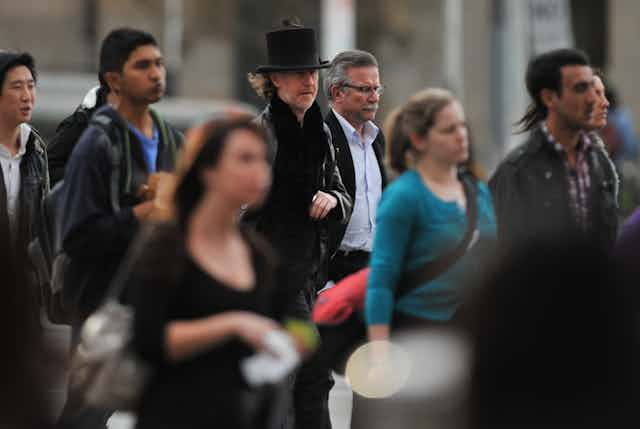This piece is part of our new Three Charts series, in which we aim to highlight interesting trends in three simple charts.
At around 1.5%, Australia’s current population growth rate is above the world rate of about 1.2%, and among the highest in the OECD.
Net international migration comprised about 55% of Australia’s population growth in 2015-16. Natural increase – that’s births minus deaths – makes up the rest.
Victoria is Australia’s fastest-growing state
Data from the Australian Bureau of Statistics show that, since about 2013, Victoria’s population growth rate has risen to become the highest of all the states and territories in Australia.
Western Australia was previously the fastest-growing state but its population growth rate has fallen sharply (by about 70% since 2011-12), likely driven by the demise of the mining boom. Queensland’s growth has declined more gradually.
Victoria’s higher population growth rate is due to it having the highest per capita rate of net international migration of all the states and territories and the largest net in-movement from elsewhere in Australia.
The most important reason for Victoria’s higher rate of net international migration was its higher per capita inflow of international students. Victoria also gained more people due to permanent migration.
After 2012, the net movement of New Zealand citizens to Australia fell rapidly (by 83% in two years). Due to its fall in numbers being shallower, Victoria replaced Queensland as the state receiving the largest net inflow of New Zealand citizens.
About 68% of the precipitous drop in Western Australia’s population growth rate since 2011-12 is because international migration to that state has fallen away. Previously, more people moved to Western Australia from the other states than in the other direction. Now, that trend has reversed.
Decreased net international migration also explains most of the decrease in Queensland’s growth rate over this period.
Big city squeeze
In recent years, Australia’s population has become increasingly concentrated in its largest cities, and several big cities are growing at well above the average Australian population growth rate.
Melbourne is Australia’s most rapidly growing city, a title it wrested from Perth around 2013-14.
Sydney’s population, which the ABS says recently reached 5 million, is also growing at above the national average rate. Net in-migration (people moving to Sydney) is the major component of Sydney’s population growth, as opposed to natural increase (births minus deaths).
Brisbane’s growth has slowed but remains above the national average. In contrast, many already sparsely settled areas in inland Australia are experiencing population decline.
The mix of overseas-born residents is changing
About 28.5% of Australia’s population was born overseas. People born in the United Kingdom are still the biggest group of overseas-born residents, making up 5% of Australia’s population. That picture is changing, however, as chart 1.2 from the ABS shows here.
The share of UK-born residents in Australia is declining, and the proportion of people born in New Zealand has grown over the last decade. Over the same period, the share of China-born residents has increased, and that’s also true for India-born residents.
Australia’s India-born resident population remain predominantly male (119 males per 100 females in 2016), although not as heavily so as previously.
In contrast to China’s male-dominated population back home, among the China-born residents in Australia females are increasingly outnumbering males (just 80 males per 100 females in 2016).

